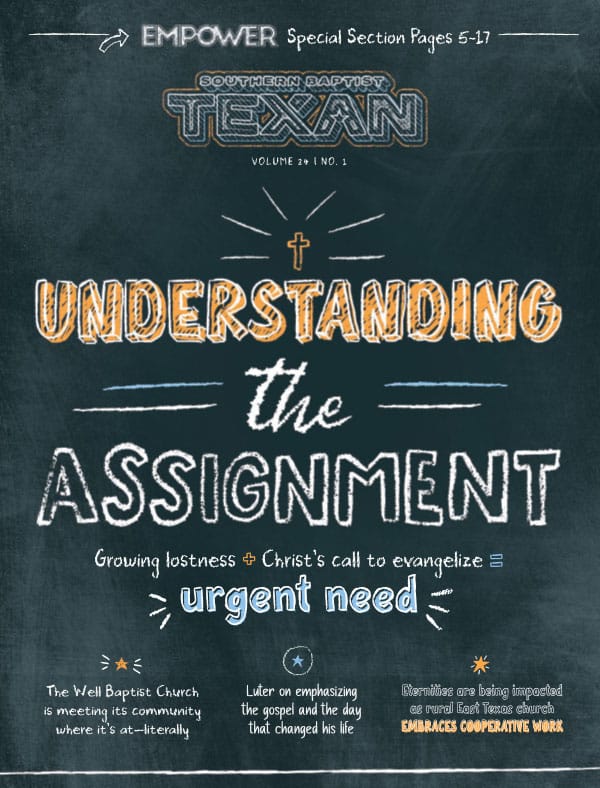SAN ANTONIO?Like it or not, Texas, you have an urban future.
Fueled by steady immigration and a rural population drain, Texas’ major city centers have seen explosive growth in the past decade. Urbanization is rapidly transforming Texas’ rural landscape into a state of globally interconnected cities filled with people of diverse culture and languages. As the majority of the state shifts to cities, Southern Baptists will be faced with unique challenges for missions, church structure, and even theology in the next decade.
As a worldwide phenomenon, urbanization is not isolated to the Lone Star state.
The 2005 UN World Urbanization Prospects Report said the 20th century is witnessing the rapid urbanization of the world. The world’s urban populations grew from 13 percent (220 million) in 1900, to 29 percent (732 million) in 1950, to 49 percent (3.2 billion) in 2005. By 2030, the UN predicts 60 percent of the earth’s population (4.9 billion) will live in major cities.
Mirroring global population trends, Texas gained 4 million people to 21.7 million residents between 1992-2002, according to a recent article in the San Antonio Business Journal. In 2002, it was estimated that about two-thirds of all Texans lived in the state’s six largest metro areas (Austin, Dallas-Fort Worth, El Paso, Houston, and San Antonio). As the U.S. Census Bureau estimates Texas’ current population at 24 million and growing, the urbanization of Texas’ major city centers is likely to continue in the next decade.
Responding to urbanization must become a priority for Southern Baptist churches, says Fred Hewett of the North American Mission Board’s church planting division.
“You cannot adequately address the need for reaching and planting churches among the urban populations,” he said, calling on all Baptists to consider the needs of their city. “[We] must recognize that most of the lost live in the heart of our cities.”
Yet statistics indicate Texas churches are not keeping up with the state’s population growth. NAMB’s Center for Missional Research (CMI) and the American Church Project reported that urbanization has only widened the gulf between Baptist churches and Texas residents. The report, conducted between 1990-2000, showed only 19 percent of all Texans attended Sunday worship services.
In the Dallas-Fort-Worth area, only 18.9 percent of the area’s total population attended church. Despite 384 new church plants in the metro area, the report estimated 711 more churches were needed to keep up with population growth.
In Austin, population growth outpaced growth among all major denominations. Only 8 percent of Austin residents attended worship services, leaving 83 percent of the population without a church home. Overall, Austin saw a 14 percent decline in attendance at evangelical churches. Although 77 new churches were planted, the area needed 415 new churches to balance out the city’s new growth.
In Houston, the Roman Catholic church grew rapidly over the last decade, in part from Hispanic migration, which grew from 21 to 30 percent of the total population. Montgomery and Fort Bend counties saw the most growth in Catholic attendance with 105.4 percent and 60.2 percent, respectively.
Despite the planting of 239 evangelical churches, 817 churches were still needed to equalize the population to church ratio.
In San Antonio, however, attendance at evangelical worship services increased in four counties: Bexar, Comal, Guadalupe, and Wilson. Although 40 percent of the city attended a Catholic church and 17 percent attended a Baptist church, the report indicated a 12 percent increase in attendance at evangelical worship services. Yet San Antonio still needed 211 churches to keep up with population growth.
Urbanization is touching every region in Texas. Along with major metropolitan areas, rural residents are also feeling the impact of this societal phenomenon. In a separate report titled “Twelve Important Changes in the American Church,” the CMI noted churches are declining faster in rural and small towns than in suburban and urban areas.
Robby Partain, director of missions for the Southern Baptists of Texas Convention, said mission strategies should consider the exit of a younger demographic from rural Texas.
“The cities are where the young people are, because that’s where the economic opportunity is,” Partain said. “The farther down (younger) you go into the generational strata, the less people attend church or even have a favorable view of organized religion.”
Partain said a good North American missions strategy will seek to influence the lost among young populations in metropolitan areas.
“If you’re a church in an urban context, urban missions should be on your front burner,” he said.
“The worst methodology is usually ‘build it and they will come’ because lost people are not looking for a cool church to attend,” Partain said. “You have to rediscover your missionary calling as a church and then go to the lost in your community. Figure out how to connect with them, bless them and share Jesus with them.”
But for churches looking to create a strategy to respond to urbanization, there are some unique challenges to consider.
Missiological Challenge
In his book “Theology as Big as the City,” pastor and urbanization guru Ray Bakke identifies some of the major challenges of an urban reality. First, Bakke believes the urban challenge is missological as the frontier of international missions has shifted to inside the borders of the United States.
“From now on nearly all ministry will be cross-cultural amid the urban pluralism caused by the greatest migration in human history from Southern hemispheres to the North, from East to West and, above all, from rural to urban,” said Bakke, who has pastored and served in inner-city churches for nearly 30 years.
In Texas, urbanization is introducing a host of new cultures and languages. Between 2000-2004, 34 percent of the state’s new population growth stemmed from immigrants. Census statistics indicate 31.2 percent of Texas currently speaks another language other than (or in addition to) English at home. And currently, the U.S. English Foundation estimates there are more than 145 languages spoken in Texas.
“The majority of the world’s non-Christians will not be geographically distant peoples,” Bakke said. Rather, they will be “culturally distant peoples who often reside together within the shadows of urban spires in the metro areas of [almost] every continent.”
Ecclesiastical Challenge
Second, urbanization presents an ecclesiastical challenge as churches consider what ministries to offer urban populations.
“The needs of the urban population are greater than ever,” said Bakke, citing the crack-cocaine epidemic, violence, homelessness, and HIV-AIDS.
And while churches may keep the same foundational functions (worship, evangelism, discipleship, fellowship, and service,) Bakke believes the church must learn to appropriately contextualize the gospel message to an urban audience.
“Most Christians still read the Bible through rural lenses. Furthermore, the evangelical church seems to be retreating even further from seeing our God as one who engages external-world reality to seeing one who meets our personal needs and solves our personal problems,” he said, noting the tension between evangelism and social aid.
“Yet the Bible clearly describes a God who is completely interested and involved in both the structures and the individuals that compose society,” said Bakke, arguing that the most effective urban strategies balance for both spiritually transforming people and socially transforming places.
Theological Challenge














